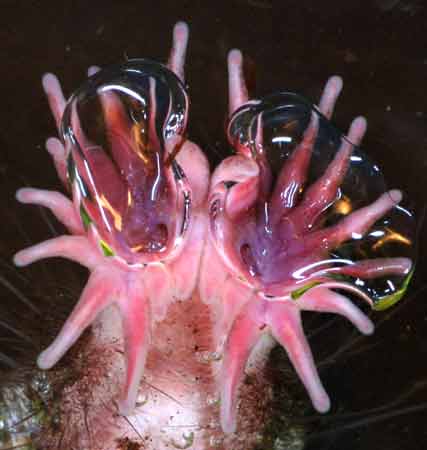Some Mammals Can Sniff Underwater

For most land mammals, trying to sniff something underwater will just result in sucking liquid up their nose. But for a couple semi-aquatic mammals, this isn't a problem--they have developed a way to sniff for food underwater, a feat previously thought impossible.
"This came as a total surprise because the common wisdom is that mammals can't smell underwater," said Kenneth Catania, a biologist at Vanderbilt University.
When searching for food, land mammals are guided to their meal by sniffing odors that travel through the air, but they have no way of detecting these odors in water.
"When mammals adapt to living in water, their sense of smell usually degenerates," Catania explained. "The primary example is the cetaceans--whales and dolphins--many of which have lost their sense of smell."
Catania began studying the possibility of underwater sniffing when he noticed that a small mammal, the star-nosed mole, that he was observing blew a lot of bubbles while swimming.
To test whether the bubbles were allowing the moles to smell, Catania stuck various objects--pieces of earthworm, small fish, and blobs of wax--to the bottom of a glass tank and used a high-speed video camera to observe the moles' behavior. [video]
When the moles swam up to the object, they rapidly exhaled bubbles through their noses, which came into contact with the object, and were then sucked back in. The moles did this between five and 10 times per second, about the same rate that mice and rats sniff the air.
Get the world’s most fascinating discoveries delivered straight to your inbox.
"Because the olfactory nerves in the nose are covered with mucous, odorant molecules are all water soluble," Catania said. "So when these bubbles come into contact with an object, it is almost inevitable that odorant molecules will mix with the air and be drawn into the nose when the bubble is inhaled."
But the star-nosed mole has what Catania called "the most unusual nose on the planet"; its nose is ringed by super-sensitive finger-like appendages that it can use to identify objects, so Catania had to rule out this factor to make sure the moles were actually smelling the object.
Catania created underwater scent trails leading to food to see how well the moles could follow them. He put a steel grid between the moles and the scent trail that prevented the nose appendages from squeezing through, but allowed the bubbles to pass through.
Even without their unusual noses, the moles had a 75 to 100 percent success rate of finding the food. When a finer grid that didn't allow bubbles to pass through was used, the moles were as likely to find the food as they were when there was no scent trail.
To see if other small semi-aquatic mammals could also sniff underwater, Catania tested water shrews, which also exhibited the bubble-blowing behavior and could follow the underwater scent trails. The results of Catania's study were published in the December 21 issue of the journal Nature.
"Now the question is, 'What other semi-aquatic mammals do this?'," Catania said. "Do animals like otters and seals do anything similar, or is there a size limit and it only works for smaller mammals?"
- The Weirdest Science Stories of 2006
- Mating Game: The Really Wild Kingdom
- Amazing Animal Abilities
- Image: Yikes! It's Fast Too!
- How We Smell

Andrea Thompson is an associate editor at Scientific American, where she covers sustainability, energy and the environment. Prior to that, she was a senior writer covering climate science at Climate Central and a reporter and editor at Live Science, where she primarily covered Earth science and the environment. She holds a graduate degree in science health and environmental reporting from New York University, as well as a bachelor of science and and masters of science in atmospheric chemistry from the Georgia Institute of Technology.


